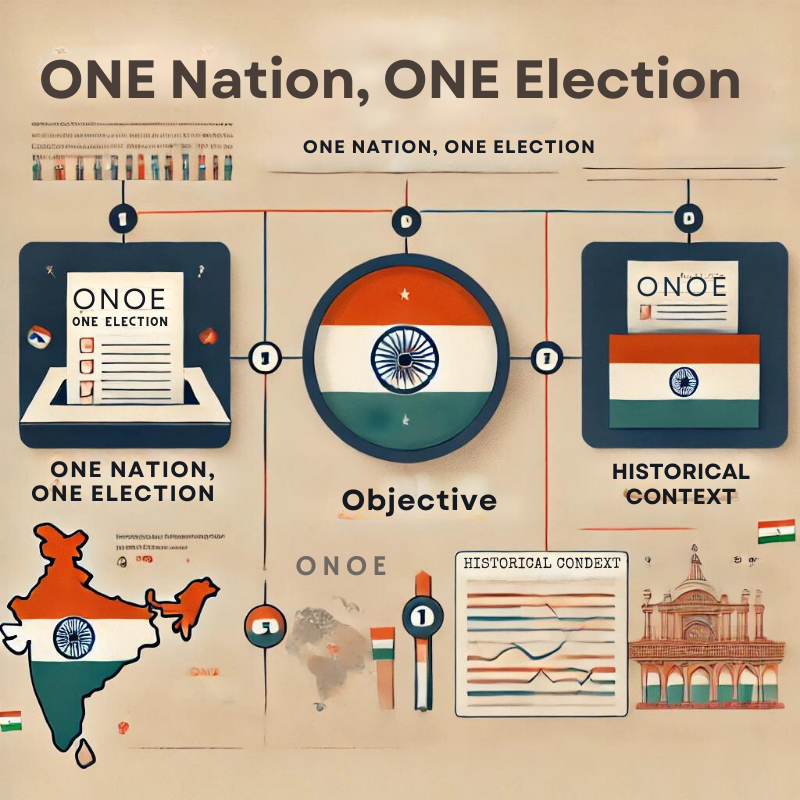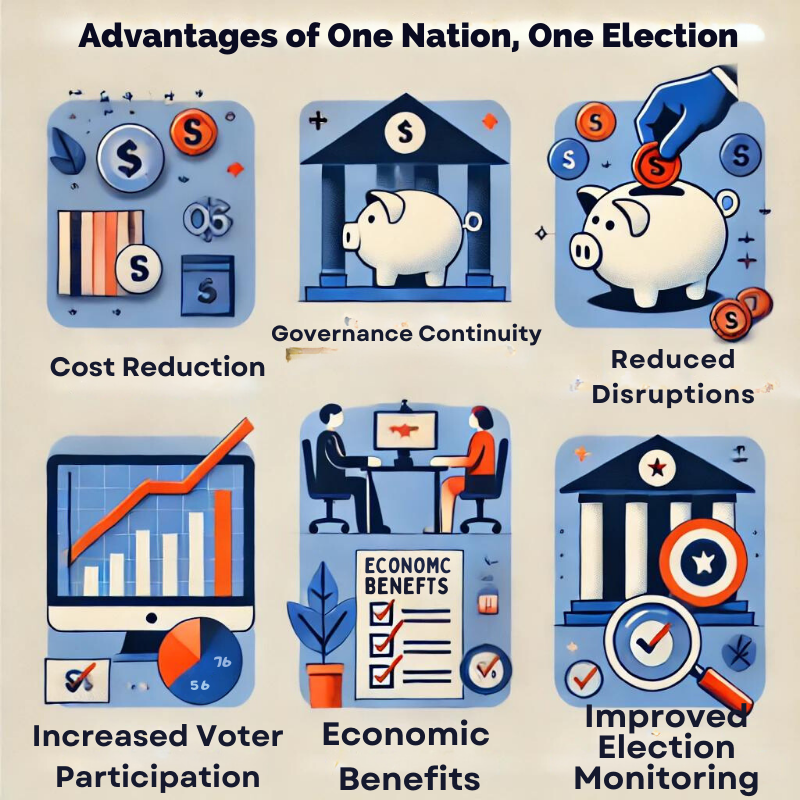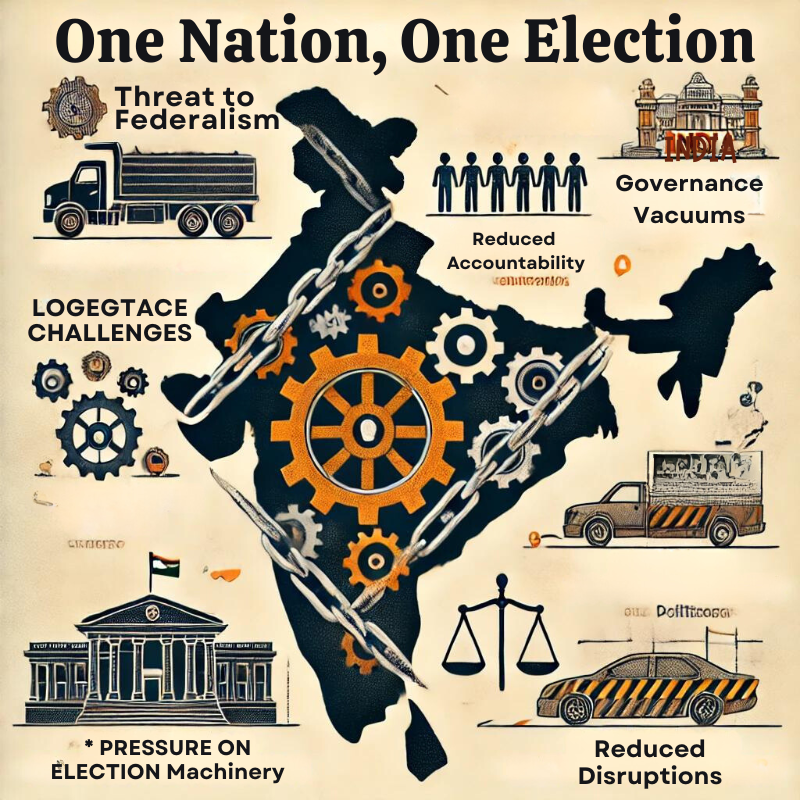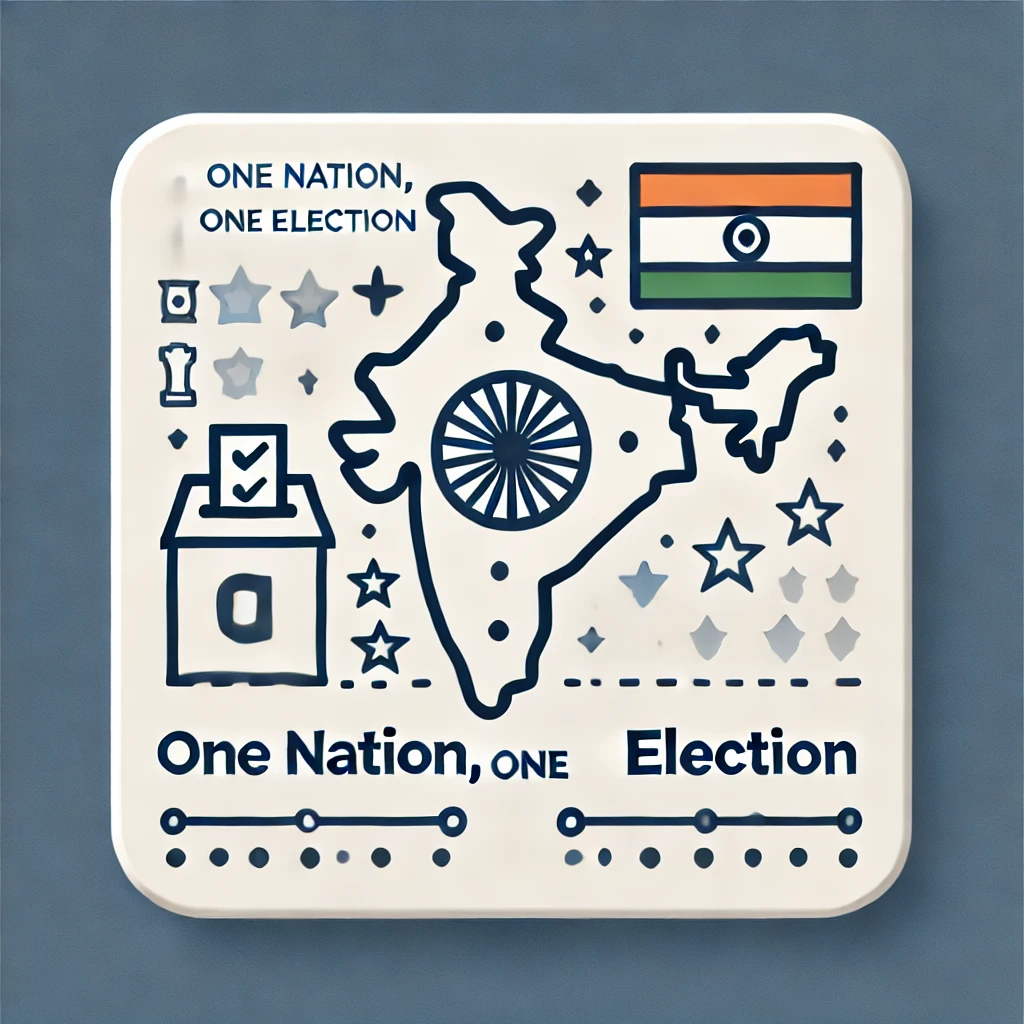The idea of One Nation One Election (ONOE) is gaining prominence in India. It is considered a suggestion to hold elections to the Lok Sabha and all State Legislative Assemblies simultaneously. The rationale behind this idea is that an electoral system of this nature could improve governance by less frequent interruption by staggered elections and enable governments to focus on policies that run for longer periods. On its other side, it can reduce the costs of elections and maximize voting.
| GS Paper | GS Paper II |
| Topics for UPSC Prelims | One Nation, One Election(ONOE), Federalism, Lok Sabha, State Legislative Assemblies, Election Commission of India’s, Model Code of Conduct, 18th Lok Sabha elections, Electronic Voting Machines (EVMs), Voter Verifiable Paper Audit Trail (VVPAT), Powers of the President, President’s Rule, Anti-Defection Law, No-Confidence Motion. |
| Topics for UPSC Mains | Significance of electoral Reforms in India. |
Origin of the Article
This editorial is based on “GOI, think through ONOE” published in The Times of India on 25/09/2024. The article highlights the need for political compromise to implement ONOE, including the central government shortening its parliamentary term to foster consensus among states.
Relevance for UPSC Aspirants
Therefore, the topic “One Nation, One Election” is really important for all UPSC aspirants to understand because it brings forth some themes which are quite relevant with respect to the UPSC syllabus, such as federalism, electoral reforms, and governance. Understanding the concept can be useful not only for Prelims but also Mains because it relates to electoral processes and political strategies.
Why in News?
The topic of “One Nation, One Election” (ONOE) is in the news due to the Union Cabinet’s recent approval of a proposal for simultaneous elections, bolstered by a report from a high-level committee chaired by former President Ram Nath Kovind. This proposal, aimed at synchronizing elections for the Lok Sabha and State Legislative Assemblies, is significant for UPSC aspirants as it ties into crucial themes of federalism, governance, and electoral reforms, which have been recurrent in previous UPSC examinations.

Overview of One Nation, One Election (ONOE)
This was One Nation, One Election, which sought to harmonize the election cycles of Lok Sabha and State Legislative Assemblies, which may go up to municipalities and panchayats. The idea was simultaneous elections at multiple levels of governments, thus reducing the increased repetition and cost element of elections. Indian practice had incorporated synchronized elections from 1951 to 1967.
Definition
ONOE stands for holding concurrent Lok Sabha, State Legislative Assembly, and even possibly local body elections that would include municipalities and panchayats. It would require drastic constitutional amendments aimed at harmonizing the electoral cycles of these bodies to ensure that all elections take place concurrently.
Objective
The basic idea of ONOE is to stagger the election process for the different levels of governments so as to align the election dates. This would require significant constitutional reforms so that the Lok Sabha, State Assemblies, and the local bodies are elected at the same time, therefore minimizing the number of electoral processes.
Historical Context
The elections to both the Lok Sabha and the State Assemblies in India were held simultaneously from 1951 to 1967. Still, it was this practice that gradually crumbled under the impacts of political instability and premature dissolution of assemblies. Therefore, with divergence in cycles, the ‘arrangements’ for elections to the Lok Sabha and State Assemblies went through hardship, which identified the possibility and drawbacks of synchronized elections.

Advantages of One Nation, One Election
ONOE promises a package of advantages: cost-effectiveness; continuity in governance; fewer disruptions; greater participation by voters; reduced hassles in campaigns; economic benefits; and enhanced monitoring of elections. These aggregate advantages seek to work their magic to improve the efficiency and effectiveness of the electoral process in India.
Cost Reduction
Even though simultaneous elections will conserve the country reams of resources, including security personnel, polling staff and election materials, the cost of conducting an election has increased manifold in India-from Rs 10.5 crore in 1951 to Rs 50,000 crore in 2019. Streamlined processes could reduce operational costs for the ECI.
Governance Continuity
Fewer elections may actually be the balm for policy paralysis; instead of constant campaigning and Model Code of Conduct, which affects governance – always straining resources, fewer elections would result in uninterrupted governance and more effective implementing of policies. It would also add administrative efficiency to the management of the country.
Reduced Disruptions
Elections would not occur very often, thus reducing interference with public life and more specifically in educational institutions used as voting places. This would allow government officials to find more time to perform their core functions and generally improve the general efficiency of administration.
Increased Voter Participation
Simultaneous elections may reduce election fatigue among the voters, hence increase the possibility of a high voter turnout and a more active role in the electoral process. Increased participation may result in stronger democratic representation.
Streamlined Campaigns
In synchronized elections, political parties would be able to concentrate their campaign efforts. Therefore, this would mean that the smaller parties would have a greater chance to present an effective competition. Sure enough, with a strong concentrated campaign by the parties, there would certainly be more efficient and focused campaigning.
Economic Benefits
The Kovind Committee report also recommended that ONOE would increase India’s GDP growth in the following year by 1.5%. Besides, the other merits of the ONOE are that it would decrease fiscal deficits, check inflow of black money and lighten up the financial burden upon the businessman regarding political donations.
Improved Election Monitoring
Simultaneous elections can thus help institute better monitoring of elections, thereby improving administrative efficiency and transparency of and fairness in electoral processes, which leads to increased citizen confidence in the electoral system.

Challenges of One Nation, One Election
Despite the numerous advantages it could bring, ONOE still poses several strong challenges, notably threats to federalism, complexity in logistics and constitutional and potential governance vacuums, reduced accountability, and immense pressure on the election machinery.
Threat to Federalism
Local issues may then be outweighed by issues important to the nation, which makes representation, both for regional voices and political diversity, less representative. This can lead voters to become confused, hence giving rise to an increase in invalid votes; this happens to go against the democratic process.
Logistical Challenges
The ECI and the security forces would face a tremendous burden in holding simultaneous elections. It calls for heavy purchase of EVMs and VVPAT, which alone would involve a cost of almost Rs 9,284.15 crore. It will face logistical problems in various other regions.
Constitutional Concerns
Onoe would require fundamental changes to the Constitution and Representation of People’s Act, of 1951. These changes may be against the precedence powers vested with the President and the state governors and, therefore, alter the balance of power.
Governance Vacuums
But rigidity of this type in a political crisis can infuse calling for early elections, thereby making the states undergo impossibly elongated epochs of Presidents’ Rule. This in turn can cause governance vacuums and inadequate representation to citizens.
Reduced Accountability
Less frequent elections may result in lessened responsibility of the elected representatives and, therefore lessen pathways for voters to express their discontent. This may make the elected representatives complacent likely having a negative effect on the responsiveness of elected representatives to the needs of constituents.
Pressure on Election Machinery
In such elections, the ECI would face great challenges because the process would be shifted to free and fair elections across the country, simultaneously, and failures or irregularities within the system would undermine people’s confidence in the electoral process and institutions, which would be a serious threat to the overall integrity of the election.
Recommendations by Various Committees on ONOE
Several committees have made recommendations regarding ONOE. Their major recommendations included phased implementation, necessary amendments of the constitution, and preparations in logistics. Such recommendations are addressed at the numerous complexities and challenges that may be involved with simultaneous elections.
High Level Committee on Simultaneous Elections
The high-level committee headed by former President of India, Ram Nath Kovind, and carrying with it several suggestions for phased implementation and very significant constitutional amendments, favored “ONOE” by calling for careful planning and tie-up for an effective implementation.
Phased Implementation
The committee suggested that in the two-phase approach, Lok Sabha and State Assembly elections be held simultaneously while finishing the entire electoral process within 100 days through local body elections. This phased approach would enable the country to adjust gradually to the new system.
Constitutional Amendments
Fifteen such amendments to the constitution were proposed, which in turn meant the committee would need two Constitution Amendment Bills. The first bill discusses transitioning into simultaneous elections, while the second one deals with local body elections and Single Electoral Roll.
New Constitutional Articles
Articles like 82A are enacted to make the otherwise gradual process of transition toward simultaneous elections possible through the concept of early dissolutions. Articles 83 and 172 have been amended to give clarity on terminologies and thus enable smooth functioning under the new order.
Local Body Elections and Electoral Roll
This new Article 324A seeks to ensure the local level elections go along with the general elections. It proposes a new Article 325(2), which talks about a Single Electoral Roll under the ECI management.
Earlier Recommendations
Among the past recommendations, the notable ones are the Law Commission (2018), Parliamentary Standing Committee (2015), National Commission to Review the Working of the Constitution (2002), and NITI Aayog (2017). All of them recommend constitutional amendment for a strict implementation of the scheme.
PESTEL Analysis
| Political: ONOE could enhance governance efficiency by reducing election frequency, allowing governments to focus on long-term policies. However, concerns arise over federalism, as national issues may overshadow regional ones, potentially weakening the influence and representation of smaller regional parties. Economic: Conducting simultaneous elections could significantly reduce election-related costs, including security, staffing, and logistics. Reduced disruptions to daily life and public services would also contribute to economic stability, with fewer election-related expenses, ultimately supporting GDP growth and reducing the influx of black money. Social: ONOE could reduce election fatigue, potentially increasing voter participation. However, voters may be overwhelmed by the scale of simultaneous elections, and local issues could be overshadowed by national concerns, undermining the representation of regional interests and making informed decision-making more challenging. Technological: Managing simultaneous elections would require vast amounts of EVMs and VVPATs, straining current technological infrastructure. The Election Commission would need to invest in enhanced logistics and monitoring systems to ensure transparency, efficiency, and fairness across the large-scale electoral process. Environmental: ONOE would reduce the environmental impact by consolidating election resources like paper, fuel, and electricity. Fewer elections would result in fewer rallies, reduced travel, and minimized resource consumption, aligning with sustainable practices and lowering the overall carbon footprint of electoral processes. Legal: Implementing ONOE would necessitate significant constitutional amendments, addressing challenges related to governance vacuums in case of premature dissolutions. Ensuring the electoral integrity of simultaneous elections across India would be a major legal and logistical hurdle, requiring comprehensive oversight to prevent potential discrepancies. |
Conclusion
The “One Nation, One Election” proposal promises to transform the electoral landscape of India by improving the efficacy of governance and reducing the high costs inherent in holding elections constantly. Proponents focus on the possible streamlined administration and better policy focus on one hand, but huge concerns remain regarding impacts on federalism, and local level representation as well as practical challenges. The choice that India takes on such a challenging issue cannot be made without holding a very comprehensive debate over the spectrum of opinions and ensuring in the process that any reform does not work against the principles of democracy and equitable representation.
| UPSC Civil Services Examination, Previous Year Questions (PYQs) Mains Q. The role of the Election Commission of India in ensuring free and fair elections is pivotal. Discuss the powers and limitations of the Election Commission under the current legal framework. (UPSC GS Paper-II, 2015) Q. Analyze the impact of the One Nation, One Election (ONOE) proposal on Indian federalism. How could simultaneous elections influence the balance of power between the center and the states? |



